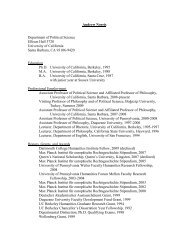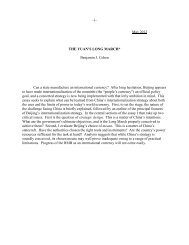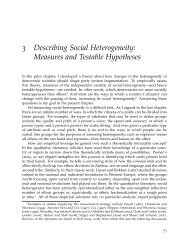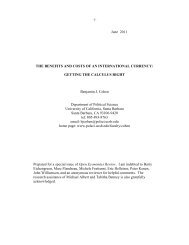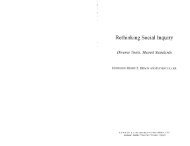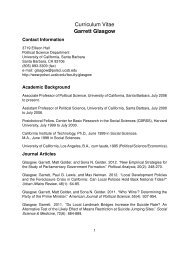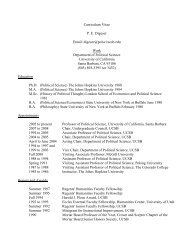Are Niche Parties Fundamentally Different from Mainstream Parties ...
Are Niche Parties Fundamentally Different from Mainstream Parties ...
Are Niche Parties Fundamentally Different from Mainstream Parties ...
Create successful ePaper yourself
Turn your PDF publications into a flip-book with our unique Google optimized e-Paper software.
526 JAMES ADAMS, MICHAEL CLARK, LAWRENCE EZROW, AND GARRETT GLASGOW<br />
positions over the range of policy shifts that we observed<br />
in Western Europe between 1976 and 1998.<br />
Finally, we emphasize that although our findings suggest<br />
that niche parties are limited in terms of the Left-<br />
Right strategies they can feasibly pursue, this is not necessarily<br />
a severe handicap, nor does it imply that niche<br />
party elites lack strategic options in pursuit of electoral<br />
and policy objectives. First, our findings in support of the<br />
Costly Policy Moderation Hypothesis suggest that niche<br />
party elites do not confront the difficult strategic tradeoff<br />
between policy “compromise” and electoral gain that<br />
mainstream politicians typically confront. This plausibly<br />
simplifies niche party elites’ decision calculus and suggests<br />
a reason why niche parties need not confront the<br />
bitter internal debates between “pragmatists” and “ideologues”<br />
that often beset mainstream parties: namely that<br />
for niche parties, policy radicalism is an electorally pragmatic<br />
strategy! Second, there is extensive research documenting<br />
that elections turn in large part on “valence”<br />
dimensions of evaluation that are not directly tied to parties’<br />
policy positions, such as party elites’ images with respect<br />
to competence, integrity, and unity (see Clark 2005;<br />
Stokes 1963). There is nothing in our findings to suggest<br />
that niche party elites cannot burnish their images with respect<br />
to these valence dimensions, thereby enhancing their<br />
party’s electoral appeal. Finally, by emphasizing new or<br />
emerging political issues (such as environmental protection<br />
and immigration policy) niche parties have opportunities<br />
to shape the “terms of the political debate,” thereby<br />
influencing the policy agendas of mainstream parties,<br />
and, ultimately, government policy outputs (see Meguid<br />
2005).<br />
Our findings raise questions that we plan to address<br />
in future research. For instance, while we have presented<br />
evidence on how Western European parties adjust their<br />
ideologies in response to public opinion—and on the electoral<br />
consequences of these adjustments—we have proposed<br />
only tentative explanations for these findings. We<br />
suspect that a satisfactory explanation for our findings<br />
may require “thick” descriptions of Western European<br />
parties’ organizational structures, and of the goals and<br />
decision-making processes of party elites and of rankand-file<br />
supporters. Alternatively, a formal modeling approach<br />
may illuminate our empirical findings. Such analyses<br />
lie outside the scope of the kinds of statistical analyses<br />
that we report here. Nonetheless, our findings represent<br />
an important step in the search to understand the linkages<br />
between public opinion, parties’ policy programs,<br />
and election results in Western Europe. We show here<br />
that niche parties in Western Europe are not responsive to<br />
public opinion and can be considered “prisoners of their<br />
ideologies”—they have no real choice other than to cling<br />
to the policy ground they have staked out for themselves.<br />
Appendix<br />
<strong>Parties</strong> Included in the Empirical Analyses<br />
Denmark<br />
Socialistisk Folkeparti<br />
(Communist)<br />
Socialdemokratiet (Social<br />
Democratic)<br />
Radikale (Liberal)<br />
Konservative<br />
(Conservative)<br />
Venstre (Liberal)<br />
Fremskridtspartiet<br />
(National)<br />
France<br />
PCF (Communist)<br />
PS (Socialist)<br />
UDF (Conservative)<br />
RPR (Conservative)<br />
FN (National)<br />
Great Britain<br />
Labour (Social<br />
Democratic)<br />
Social and Liberal<br />
Democrats (Liberal)<br />
Conservative<br />
(Conservative)<br />
Greece<br />
K.K.E. (Communist)<br />
PA.SO.K (Social<br />
Democratic)<br />
New Democracy<br />
(Christian)<br />
Italy<br />
PCI (Communist)<br />
PSI (Social Democratic)<br />
AN (National)<br />
DC (Christian)<br />
PLI (Liberal)<br />
Luxembourg<br />
KP/PC (Communist)<br />
LSAP/POSL (Social<br />
Democratic)<br />
CSV/PCS (Christian)<br />
DP/PD (Liberal)<br />
The Netherlands<br />
PPR/PvDA/D’66 (Social<br />
Democratic)<br />
CDA (Christian<br />
Democratic)<br />
VVD (Liberal)<br />
GL (Green)<br />
Spain<br />
IU (Communist)<br />
PSOE (Social Democratic)<br />
CIU/AP/CP<br />
(Conservative)<br />
CDS (Liberal)<br />
Note: The names in parentheses indicate the “party families”<br />
to which parties belong. Party family designations are taken<br />
<strong>from</strong> the Comparative Manifesto Project, where the third digit<br />
of the party identification code represents a party’s family.<br />
We note that for the purposes of our empirical analyses, the<br />
parties that the CMP classified as members of the Communist,<br />
Social Democratic, and Green families were classified as leftwing<br />
parties in our analyses, while parties the CMP classified<br />
as belonging to the Conservative, Christian, and Nationalist<br />
families were classified as right-wing parties. We classified as centrist<br />
all parties belonging to the CMP’s Liberal family classification.<br />
References<br />
Adams, James. 2001. Party Competition and Responsible Party<br />
Government: A Theory of Spatial Competition Based Upon




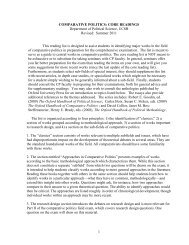
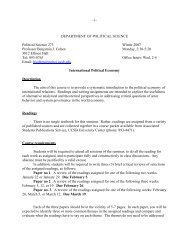

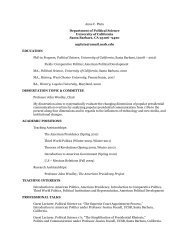
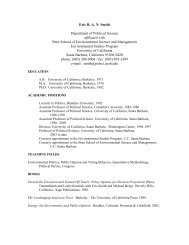
![Curriculum Vitae [abbreviated] John T. Woolley Professor of Political ...](https://img.yumpu.com/25423597/1/190x245/curriculum-vitae-abbreviated-john-t-woolley-professor-of-political-.jpg?quality=85)
